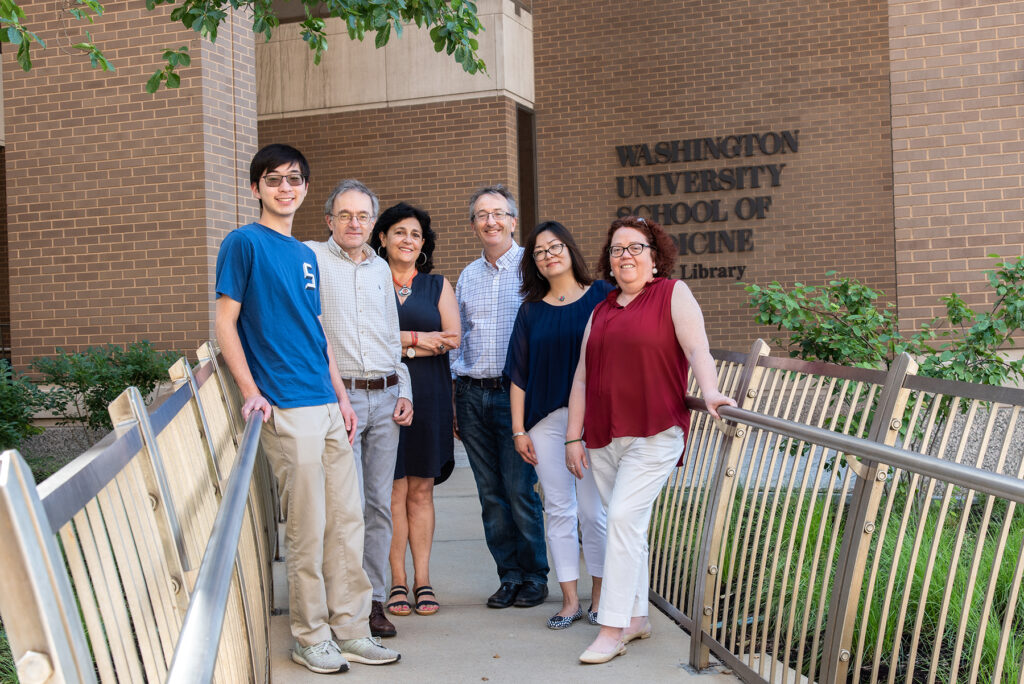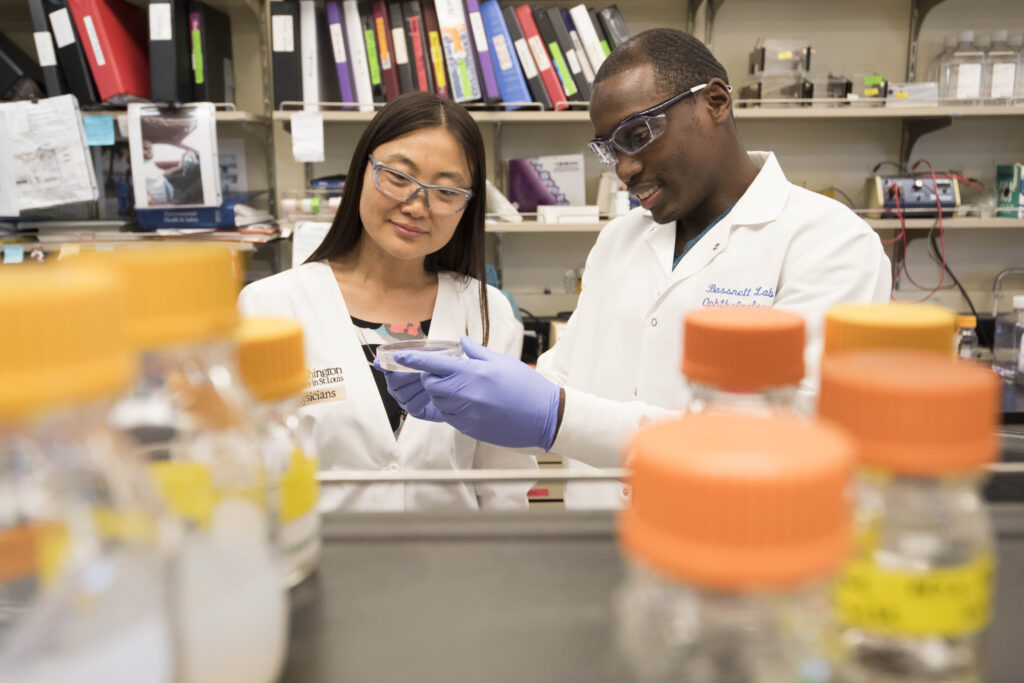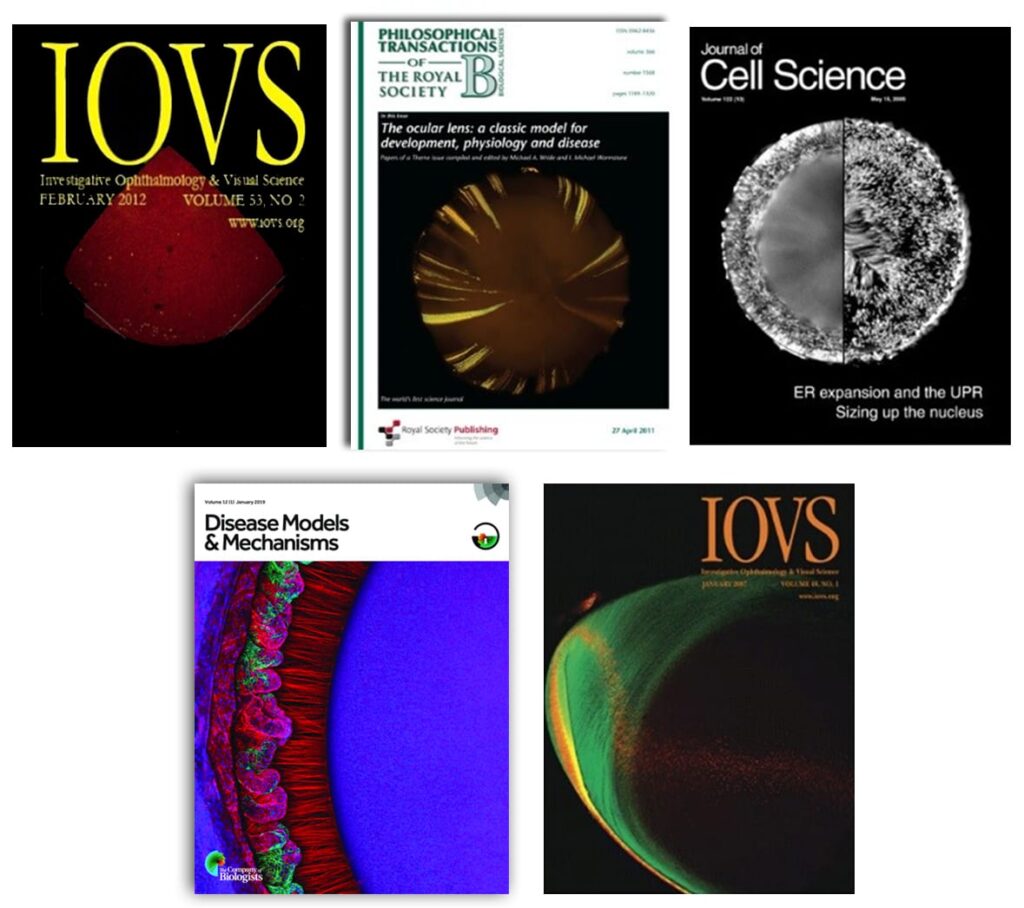Bassnett Lab
Steven Bassnett, PhD, Professor, Ophthalmology & Visual Sciences, Cell Biology & Physiology

Research Overview
We study the development, cell biology, and pathology of the image-forming tissues in the eye’s anterior segment. Small changes in the size or shape of ocular structures can have profound effects on vision but the mechanisms that control the growth and form of ocular tissues are not well understood. We use mathematical models in conjunction with cell lineage tracing and in vivo imaging to understand how the growth of the lens (a model system) is specified. We are especially interested in the relationship between the physical forces that act on the lens and its growth. For example, mutations in genes encoding proteins of the ciliary zonule (the system of elastic fibers that suspends the lens in the eye) lead to an undersized lens. How the forces applied to the lens surface by the zonular fibers are transduced into appropriate growth responses is an ongoing area of interest.
The eye also responds to the quality of images projected onto the retina. A blurred image can cause the axial length of the eye to increase; the result of reorganization of collagen fibers in the eye wall (sclera). Every millimeter of excess eye growth results in 3 diopters of refractive error (myopia). We are using advanced imaging and single cell RNA sequencing to study the behavior of the fibroblasts that inhabit the eye wall and play an active role in its remodeling. We hope such studies will guide the development of therapies to prevent or reverse high myopia.
The pressure within the eye is usually maintained within strict limits. However, certain conditions can cause the pressure to increase, leading to retinal damage and vision loss (glaucoma). In conjunction with our clinical colleagues, we are examining one form of glaucoma (exfoliation glaucoma) in which aggregated protein fibrils are produced within the eye. The fibrils accumulate in the drainage structures, causing increased outflow resistance and elevated intraocular pressure. Using mass spectrometry and high resolution electron microscopy, we are studying the composition and ultrastructure of the exfoliation material, with the goal of developing methods to disaggregate the fibrils and lower intraocular pressure.
Our work is funded primarily through grants from the National Eye Institute of the NIH.
We have also received support from the Marfan Foundation, Glaucoma Research Foundation, Research to Prevent Blindness (RPB), the European Union, and the Grace Nelson Lacy Glaucoma Fund.

Publications
Some recent publications from the Bassnett Lab
Shi, Y., Jones, W., Beatty, W., Tan, Q., Mecham, R.P., Reinhardt, D.P., Gibson, M.A., Reilly, M.A., Rodriguez, J., Bassnett, S. (2021) Latent-transforming growth factor beta-binding protein-2 (LTBP-2) is required for longevity but not for development of zonular fibers. Matrix Biology, 95:15-31. PMCID: PMC8276913.
Bassnett, S. (2021). Zinn’s zonule. Progress in Retinal and Eye Research. doi: 10.1016/j.preteyesres.2020.100902. PMCID: PMC8139560.
Jones, W., Rodriguez, J., Bassnett, S. (2019). Targeted deletion of fibrillin-1 in the mouse eye results in ectopia lentis and other ocular phenotypes associated with Marfan syndrome. Disease Models and Mechanisms. doi:10.1242/dmm.037283. PMCID: PMC6361150.
Majtan, T., Jones, W., Krijt, J., Park, I., Kruger, W.D., Kozich, V., Bassnett, S., & Kraus, J.P. (2018) Enzyme replacement therapy ameliorates multiple symptoms of murine homocystinuria. Molecular Therapy, 26(3):834-844. PMCID: PMC5910661.
Vinberg, F., Wang, T., De Maria, A., Zhao, H., Bassnett, S., Chen, J., & Kefalov, V. (2017). The Na+/Ca2+, K+ exchanger NCKX4 is required for efficient cone-mediated vision. Elife. e24550. PMCID: PMC5515578.
Šikić, H., & Bassnett, S. (2017). The lens growth process. Progress in Retinal and Eye Research, 60:181-200. PMCID:PMC5605917.
De Maria, A., Wilmarth, P.A., David, L.L., & Bassnett, S. (2017) Proteomic analysis of the bovine and human ciliary zonule. Investigative Ophthalmology and Visual Sciences 58(1):573-585. PMCID:PMC5283081.
